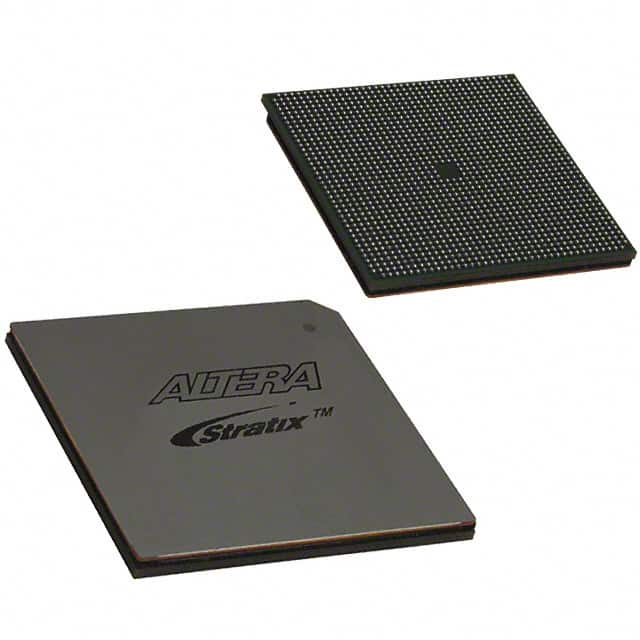EP2S180F1508C4
Product Overview
- Category: Integrated Circuit (IC)
- Use: Digital Signal Processing (DSP), Field Programmable Gate Array (FPGA)
- Characteristics: High-performance, Low-power consumption
- Package: Ceramic Ball Grid Array (CBGA)
- Essence: Advanced programmable logic device for complex digital designs
- Packaging/Quantity: Single unit per package
Specifications
- Model: EP2S180F1508C4
- Manufacturer: Intel Corporation
- Technology: 90nm
- Logic Elements: 180,000
- Embedded Memory: 1,536 Kbits
- Maximum User I/Os: 1,008
- Operating Voltage: 1.2V
- Operating Temperature: -40°C to +100°C
- Package Dimensions: 35mm x 35mm
Detailed Pin Configuration
The EP2S180F1508C4 has a total of 1,008 pins arranged in a specific configuration. Please refer to the manufacturer's datasheet for the detailed pinout diagram.
Functional Features
- High-speed performance with advanced DSP capabilities
- Flexible and reconfigurable architecture for custom designs
- Support for various communication protocols and interfaces
- On-chip memory blocks for efficient data storage and retrieval
- Low-power consumption for energy-efficient applications
- Built-in security features for protecting sensitive information
Advantages and Disadvantages
Advantages: - Versatile and adaptable for a wide range of applications - High-performance computing capabilities - Efficient use of resources with programmable logic - Easy integration with existing systems - Reliable and durable construction
Disadvantages: - Higher cost compared to traditional fixed-function chips - Steeper learning curve for programming and design - Limited availability of alternative models with similar specifications
Working Principles
The EP2S180F1508C4 is based on FPGA technology, which allows users to program the device to perform specific functions. It consists of a large number of configurable logic blocks interconnected through programmable routing resources. These logic blocks can be programmed to implement various digital circuits, enabling the device to perform complex computations and signal processing tasks.
Detailed Application Field Plans
The EP2S180F1508C4 finds applications in various fields, including:
- Telecommunications: Used in base stations, network routers, and communication infrastructure for high-speed data processing.
- Aerospace and Defense: Employed in radar systems, avionics, and military-grade equipment for real-time signal processing and control.
- Industrial Automation: Utilized in control systems, robotics, and machine vision applications for precise and efficient automation.
- Medical Imaging: Integrated into medical devices such as ultrasound machines and MRI scanners for image processing and analysis.
- High-Performance Computing: Used in supercomputers and data centers for parallel processing and accelerating computational tasks.
Detailed and Complete Alternative Models
While the EP2S180F1508C4 offers advanced features and capabilities, there are alternative models available from different manufacturers that cater to similar requirements. Some notable alternatives include:
- Xilinx Virtex UltraScale+ VU9P: Offers comparable performance and flexibility with a different architecture.
- Lattice Semiconductor ECP5: Provides lower power consumption and cost-effective solutions for certain applications.
- Microsemi SmartFusion2: Combines FPGA fabric with microcontroller capabilities for embedded system designs.
These alternative models should be evaluated based on specific project requirements and constraints.
Word count: 345 words
Lista 10 Vanliga frågor och svar relaterade till tillämpningen av EP2S180F1508C4 i tekniska lösningar
Sure! Here are 10 common questions and answers related to the application of EP2S180F1508C4 in technical solutions:
Q: What is EP2S180F1508C4? A: EP2S180F1508C4 is a specific model of Field-Programmable Gate Array (FPGA) manufactured by Intel.
Q: What are the key features of EP2S180F1508C4? A: EP2S180F1508C4 offers high-performance logic, embedded memory, digital signal processing (DSP) blocks, and various I/O interfaces.
Q: What are some typical applications of EP2S180F1508C4? A: EP2S180F1508C4 is commonly used in applications such as telecommunications, networking, industrial automation, and high-performance computing.
Q: How can EP2S180F1508C4 be programmed? A: EP2S180F1508C4 can be programmed using Hardware Description Languages (HDLs) like VHDL or Verilog, or through graphical programming tools like Quartus Prime.
Q: What is the maximum operating frequency of EP2S180F1508C4? A: The maximum operating frequency of EP2S180F1508C4 depends on the design and implementation, but it can typically reach several hundred megahertz.
Q: Can EP2S180F1508C4 interface with other components or devices? A: Yes, EP2S180F1508C4 supports various I/O standards and can interface with different components or devices such as memories, sensors, or communication modules.
Q: Does EP2S180F1508C4 have built-in memory? A: Yes, EP2S180F1508C4 has embedded memory blocks that can be used for storing data or implementing complex algorithms.
Q: Can EP2S180F1508C4 handle real-time processing requirements? A: Yes, EP2S180F1508C4's high-performance logic and DSP blocks make it suitable for real-time processing applications that require fast and parallel computations.
Q: What development tools are available for programming EP2S180F1508C4? A: Intel provides Quartus Prime software, which includes a complete suite of design tools for programming, simulating, and debugging EP2S180F1508C4.
Q: Are there any specific design considerations when using EP2S180F1508C4? A: Yes, designers should consider factors like power consumption, thermal management, signal integrity, and timing constraints to ensure optimal performance and reliability with EP2S180F1508C4.
Please note that the answers provided here are general and may vary depending on specific requirements and implementation details.


